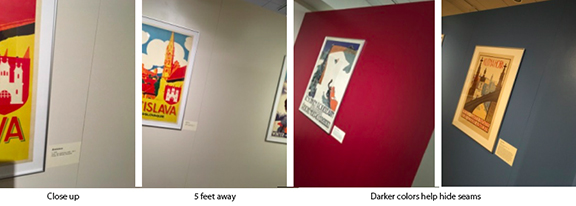Frequently Asked Questions
Since there’s really nothing on the market quite like our portable walls, we’re often asked questions about what they look like and how they work. Here are some answers to help you determine whether our portable wall system is right for your application.

How do our walls join together?
Our portable walls are joined together by parts we call “Joiners”. These are wooden tabs which slide into the receiving ends between portable wall sections. There are five Joiners per section. We recommend the top Joiner is screwed into place using a common wood screw or Phillips drill bit. This will help prevent the walls from sliding apart if they are moved.
What are the walls made of?
Pareti’s Mobile Walls feature all biodegradable products. They’re made of a precision-machined internal plywood (birch or pine) core, and clad in a sealed hardboard (MDF). All sections are glued together and nailed during the manufacturing process, creating an amazingly strong and rugged system.
What do the walls look like up close?
Over time, when painted and re-painted, the texture of the walls appear more and more like real walls. The hardboard finish is smooth and accepts paint, graphics, and vinyl wrap very well.

Can you see the seams between the walls?
Yes there are seams, and in some cases these are very easy to see. While the seams between walls are difficult to photograph, they are visible when standing in front of the walls. However, when walls are painted a color (versus white) these seams tend to be much less noticeable.

Can I paint the walls?
Yes! Paint and repaint. In fact, the more often you paint them the more the texture will look like real walls.
Can I have my walls on casters instead of adjustable feet?
We plan to introduce a new product which will allow you to turn our standard walls into walls on casters. Don’t let that hold you up! You’ll still be able to use our standard walls with our retrofitting design. We think this option will allow customers to decide when to make their wall sections easily moveable and rollable, and when to make them virtually immovable and more like real walls.
Can I have a simple, flat wall with no returns?
Our walls rely on counter balance to stand, and therefore require a return. We often suggest you consider a minimum 6 ft or 8 ft of walls connecting to a “T” or “L” section on both sides.
Can I connect directly to an existing wall?
Yes! We offer products which allow you to connect directly to an existing (permanent) wall stud in your building. This requires 3 screws into your wall, and our portable walls can be built out from that. You will still need a return at the end of your wall for stability. To learn more about our new Easy Build-Out wall system, click here.
Can I place a door in a portable wall?
Yes. We build custom sections which include doors (locking or unlocking). Doors can range in size from 24″ to 36″, and can feature plain, basic interior doors, or more formal bevelled door panels. You can also select door handle finishes (such as brushed silver, gold, bronze, aged, and other looks), and types of handles like levers or knobs, to help you achieve the look you want.
How much do the walls weigh?
Standard 4′ x 8′ walls, “T” and “L” sections weigh around 100 lbs. 2′ x 8′ walls weigh approximately 75 lbs. We now also offer “Mini” “L” and “T” sections which only use a 1’x1′ footprint and are much easier to ship and carry.
How long does set up take?
To set up a standard 16 foot wall takes about 30 minutes for set up and leveling. (Carrying the walls will add to that time, but it depends on how far away they must be carried.) Your first time will not go that fast, so count on about 45 minutes or so until you get the hang of leveling the walls. What’s this leveling we’re talking about? Check out the installation video here.
Can the walls fall or topple?
Yes! This is very important. Without proper counter balance and weight the walls can definitely fall or topple. This is why designing your floor plan and leaving room for alteration when your walls arrive is so critical. Since flooring differs from venue to venue, it is up to you – the designer – to determine the safety of your exhibit or floor plan. It is imperative to plan for uneven flooring, and to design your floor plan accordingly. Our internal tests have shown the most stable portable wall floor plans appear (when looking overhead) in a “+” or a square formation, since we’ve found these don’t wobble and are more tip resistant due to weight. However, since our walls are not anchored, they can still be moved with enough force. Be sure to check out this page, Designing for Safety.
How long do the walls last?
If taken care of and kept away from moisture, the walls are designed to last for years. Some sets have been in continual use – constantly being moved and painted for temporary exhibits for well over four years, and are still looking great. Since the walls can be easily repaired with ordinary items from your local hardware store, maintenance is much simpler and more intuitive.
How much weight can a wall hold?
Our customers hang all sorts of things on our walls – framed artwork, stereo speakers, footwear, Grammy awards, large flat screen televisions, air conditioners, acrylic displays, small shelving, and more. No matter what you hang, however, the first requirement is stability – you must have a solid, tip-resistant floor plan, especially if you plan on hanging heavier objects.
Want to see for yourself? Download this collection of photos showing the types of things customers hang on our walls.
